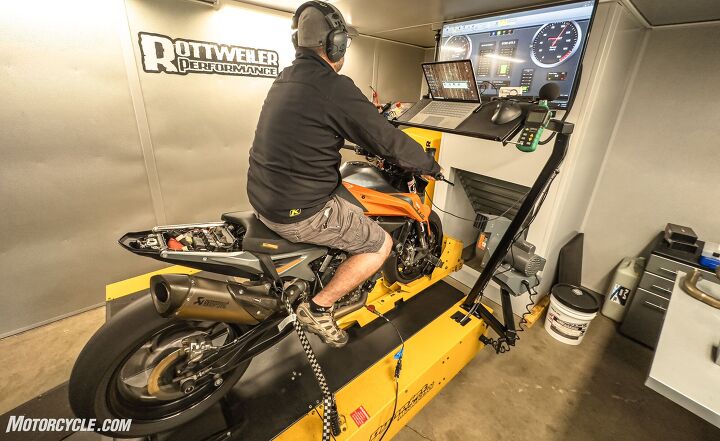Motorsports Racing News & Blog Articles
MO Tested: Rottweiler Performance Intake System For The KTM 790/890 Duke Review
My love for the KTM 790 Duke has been well documented on MO, but the reality is that had KTM been a little less tight-lipped when I was laying down my hard-earned cash for the bike, I might never have owned it. Instead, an 890 Duke R would probably be parked in my garage. That doesn’t lessen my attachment to the 790, but it helps to explain my desire to squeeze as much power out of the parallel-Twin as I can, while maintaining its social acceptability on exhaust sound. (OK, maybe being mocked in the comments when the Akrapovic slip-on resulted in slightly lower peak power has a little to do with my search for power, too.) Regardless, my unspoken goal for my performance modifications has been to get as close as possible to a stock 890’s mid-range power. From the moment Rottweiler Performance released its Rally Edition Full Intake System for the 790/890 Adventure, I’ve been salivating at the prospect of installing an adapted version on my Duke. Well, with the release of the Rottweiler Performance Intake System for the KTM 790/890 Duke, that wait is over, and man, does it kick some butt.
KTM 790 Duke Project: Building A 790 R
Rottweiler Performance Intake System For The KTM 790/890 Duke| + Highs An honest 10 hp over stock at 5,700 rpm Luscious intake sound Shave 1.7 lb with carbon fiber (0.25 lb less savings with plastic) | – Sighs This kind of power increase doesn’t come cheap Closed course use only We had to wait over a year for it to hit the market |
Shop for the Pro Version Rottweiler Intake System For The KTM 790/890 Duke here
Shop for the Race Version Rottweiler Intake System For The KTM 790/890 Duke here
What’s in the kit?
The Intake System for the KTM 790/890 Duke is a complete replacement for the Duke’s airbox, and it comes in two functionally identical varieties: PRO (plastic in a choice of black or orange) and RACE (in gloss or matte carbon fiber). The system is designed to act as a single velocity stack, funneling the air from the huge surface area of the foam off-road filter straight to the throttle bodies. Now, the beauty of OEM EFI is that simply adding a Rottweiler intake can have the fuel mixture requirements automatically accounted for by the oxygen sensors – even with a stock exhaust. While I didn’t test this on my bike, Rottweiler claims that its 790 Adventure test mule gained 9 hp with the intake only. However, my Duke was already modded with an Akrapovic slip-on with the quiet baffle removed, a Rottweiler Power Plate intake kit, and a Dynojet Power Commander V, running a custom map, as the starting point of this phase of modifications. Although the fueling with my current setup was spot on, my quest for power dictated that I toss the entire airbox, and its accompanying weight, in favor of the carbon fiber Rottweiler unit.
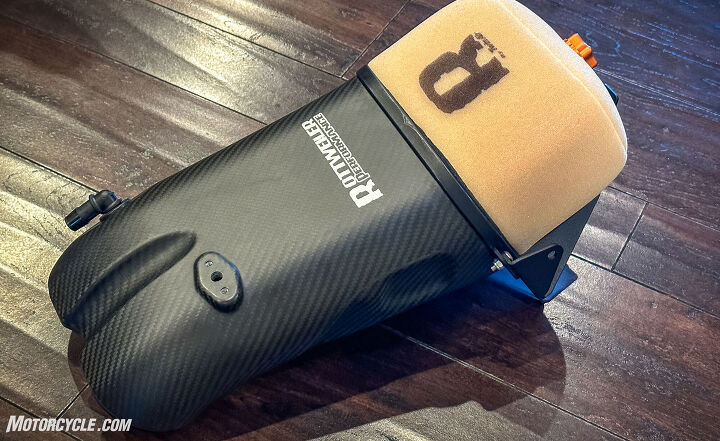
In addition to what’s seen here, the Rottweiler Performance Intake System for the KTM 790/890 Duke comes with all the necessary hardware for installation.
The installation of the kit took a little less than two hours, but I was working without instructions. (Rottweiler hadn’t written them when I received the kit way back in November.) While the tank’s accompanying bodywork had to be removed, the tank itself only had to be loosened to allow better access to the throttle body boots. Additionally, the left half of the subframe needed to be unbolted and left to hang by the wiring harness on the side of the bike. The most challenging tasks in the whole installation were removing the boots from the throttle bodies and remounting them once they were attached to the new intake. All it took was a little patience plus some WD-40 on the mounting surfaces, and they eventually popped into place.
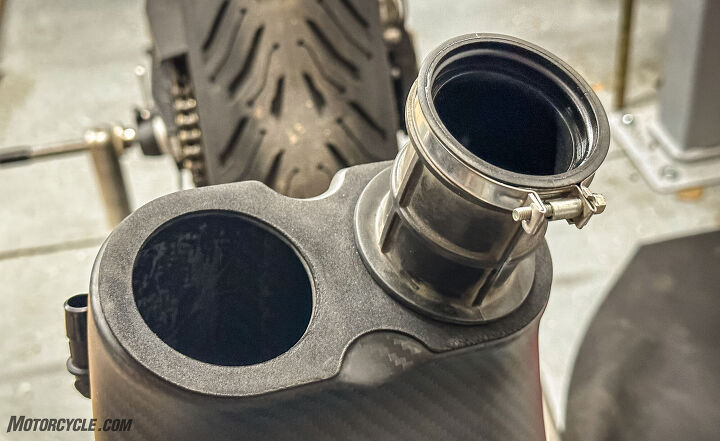
An example of the attention to detail is that a laser-cut foam gasket is mounted to the intake to account for the variation in thickness of the carbon fiber. This creates an interference fit that prevents an air leak and any ingress of dirt. A nice touch!
The attention to detail on the intake kit is what I’ve come to expect from Rottweiler. From the laser-etched mounting bracketry, to the hose and temperature sensor mounts, to the machined aluminum knob to secure the air filter, everything lined up without the finessing frequently required with aftermarket parts. Once the bike is all buttoned up the only hint of this mod is the bit of yellow filter you can see through the mesh opening in the subframe – and the intake sound when you start the engine. Having the system hidden really is too bad because the matte carbon fiber looks really nice.
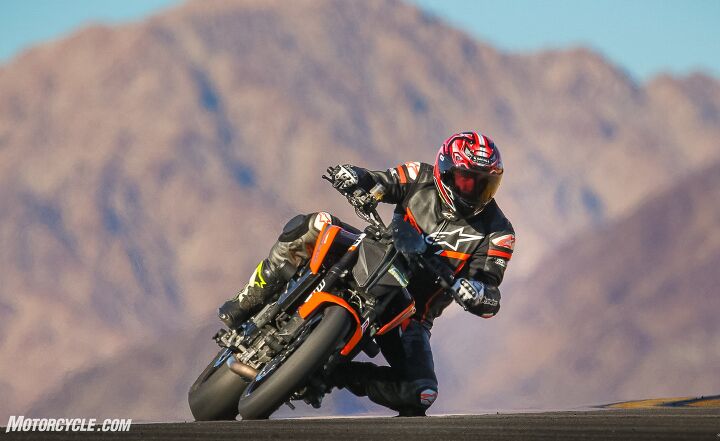
While the power had increased noticeably, the fueling wasn’t as spot on as with a map tuned for my setup.
Initial twist of the throttle
Two days after installing the Rottweiler intake, I was at Chuckwalla Valley Raceway for my first test of the system (without updating the fuel maps). The additional power out of the corners was immediately noticeable. Chuckwalla was the perfect venue for this test because of the frequent corners allowing me to feel the midrange punch and tractability. By my second session, I’d needed to move my shift points about 20-30 feet closer to the corner exit. While the throttle response was good, it wasn’t as seamless as the previous map that was set up for the exact condition of my bike. Additionally, there were whole sections of the rpm range that the ECU had a stranglehold on, and the Power Commander could only access the ignition timing. More power was waiting to be unlocked.
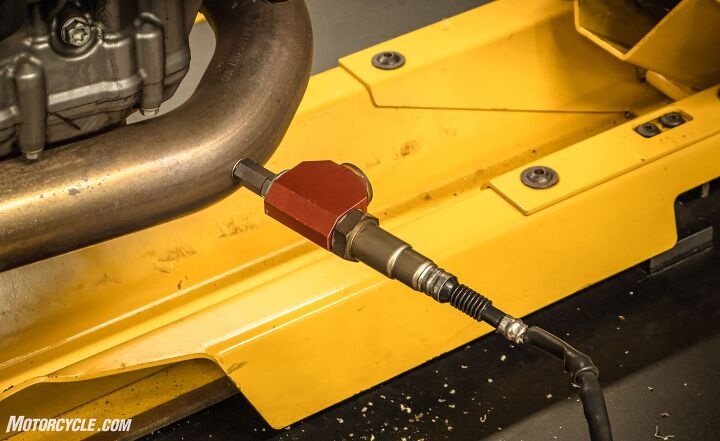
When making maps for a performance product, Rottweiler still needs a wide-band O2 sensor to figure out what is going on in the exhaust. This allows for the Power Commander’s map to be tuned very specifically.
Dyno tuning
While the stock ECU can deliver most of the power that the intake kit is capable of, my lust for power led me to chase the maximum out of the increased airflow by taking the OEM oxygen sensors out of the process to put full control of fueling into the hands of the Power Commander and Rottweiler map. This decision has three consequences: it’s for track use only, it will disable cruise control on bikes equipped with it, and the Check Engine light will be on continuously. The reader needs to decide if they are willing to accept these issues. In case you were wondering, taking the O2 sensors out of the equation does not remove the ECU’s ability to account for things like altitude because of the barometric pressure sensor, among others, on the bike – which is just a long way of saying the ECU can still adapt the tuning for changing conditions.
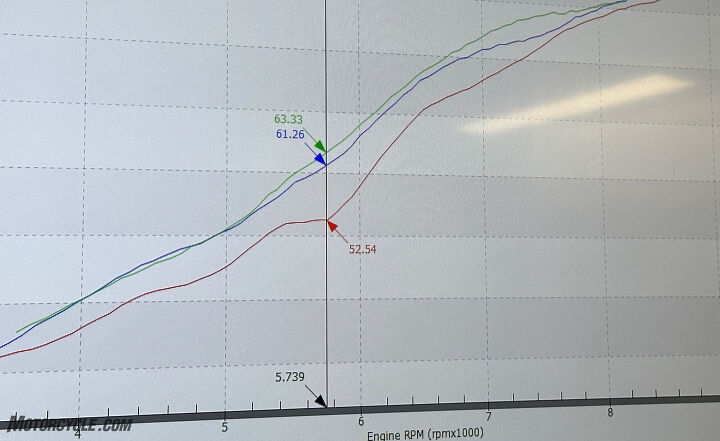
The fueling issues I felt on the track are shown here: Blue is the intake and Power Commander with my previous map, and the Green is with the intake-specific map. While the difference isn’t numerically huge, the driveability improvement is quite noticeable. For comparison, red is the box stock number the Duke started with.
Developing the map for the intake with the OEM O2 sensors disabled requires that a hole be drilled in the header for the Dynojet O2 sensor to attach. After that, multiple runs at 20%, 40%, 60%, 80%, and 100% throttle were made to determine the maps for optimal running at those throttle settings throughout the rpm range. The Dynojet software takes care of transitioning between those throttle settings. With each dyno run and tweak to the map, the power delivery gets optimized until the map is complete. Then it is ready to be downloaded into Power Commanders on bikes with a similar configuration. This is the process that Rottweiler goes through for each of the maps it creates for its performance products. Consequently, end users don’t need their header tapped for the O2 sensor. Instead, they just load the map on the Power Commander and reap the benefits.
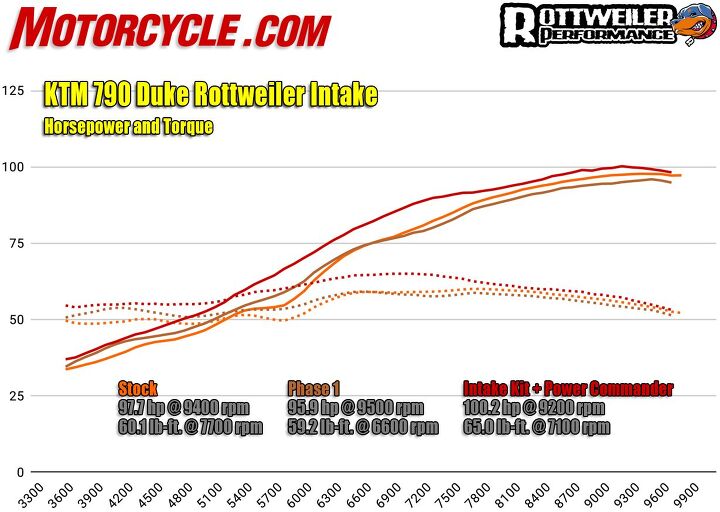
How does 10.8 hp over stock at 5,700 rpm sound? The increase in peak power is nice, but the mid-range is where engines spend most of their time. Phase 1 was where I’d last made changes to the power delivery with the PCV and Rottweiler Power Plate.
Back to the track
For my second track test of the Rottweiler Intake System, I took the 790 to the banking of Auto Club Speedway for the last motorcycle event ever in its current configuration. Since I’d never ridden the Duke here, I can’t comment on the effect of the mapping on the shift points. However, there are several straights on the track where I accelerated to over 100mph, including the front straight where I saw just over 140mph (with my butt way back over the tail section and my chin on the tank). From 5,000 rpm – 7,800 rpm, the improved power was intoxicating. Where there had been softness, I found a seamless rush of power that initially surprised me – even though I’d ridden the bike prior to mapping. A look at the dyno chart above tells the story. In fact, at 5,700 rpm, my 790 comes within 5.4 hp of a stock 890 Duke R, making me very happy.
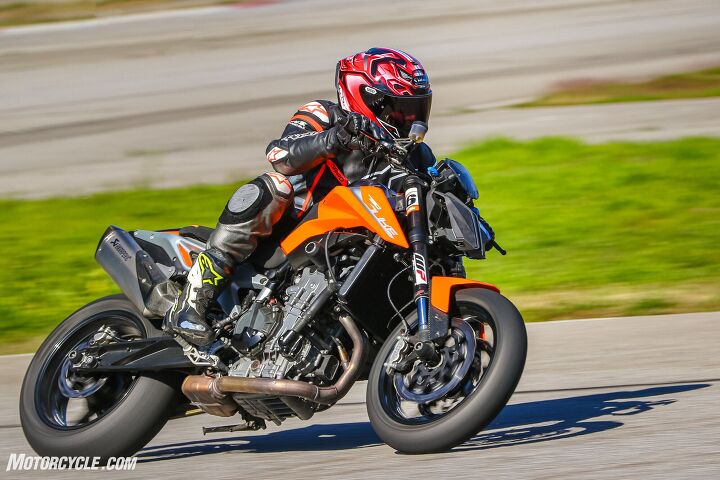
My 790 Duke feels like a different motorcycle! It launches out of the corners with ferocity, thanks to the Rottweiler Intake and Power Commander’s tuning.
Carving the canyons
Oftentimes, performance modifications carry a cost when riding on the street, but riding around the local mountains revealed seamless power that responds, with one exception, to every twist of the throttle – be it on or off throttle. Around town, the docile performance feels just like it did when the bike was stock – until I pull its tail. Get to more open environments, and the Duke leaps forward like it does at the track. Riding in the real world, where a single unfamiliar corner can have multiple on/off/on throttle adjustments, the combination of the intake and the mapping produces the type of smooth transitions that I crave as a rider. The only caveat is that at engine speeds below about 4,000 rpm, whacking the throttle wide open from a steady state (like you would for a dyno run) produces a momentary hesitation before launching forward. In practical terms, I’ve never encountered this on the street. At the track, if you let the rpm drop that low, you’ve already botched the drive out of a corner. So, this is really a nonissue.
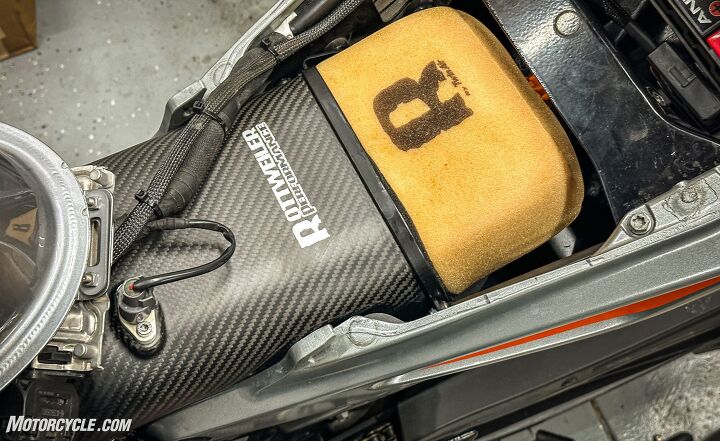
Everything in its place. The filter is oiled, and you can even see the Power Commander attached to the battery in the top right corner.
In summary, the intake kit and the Power Commander combined deliver more power throughout the entire rpm range, with a 19% increase in power at 5,700 rpm, and those big gains carry through to almost 8,000 rpm, which is the meat of your street-riding zone. Without the Power Commander, the bulk of the power is still available. For those who crave even more power (at the expense of a considerable increase in noise), a full exhaust coupled with the intake should bump the power up even more. For people who want to take the modifications even further down the power-chasing rabbit hole, the Dynojet Auto Tune, with its wide-range O2 sensor can free up more, but increasingly smaller, slices of horsepower. Consequently, the $650 price as tested for the carbon fiber Race System seems reasonable, though certainly not cheap, in terms of dollars per horsepower, and the plastic Pro System delivers the same performance increase for $400, while decreasing the cost per pony. The really cool thing about the system is that it fits both 790 and 890 Dukes, delivering the same benefits. Imagine the 890 Duke with a similar bump of power in the midrange!
Shop for the Pro Version Rottweiler Intake System For The KTM 790/890 Duke here
Shop for the Race Version Rottweiler Intake System For The KTM 790/890 Duke here
Related reading
KTM 790 Duke Project: Building A 790 R
MO Tested: Dynojet Power Commander V And Rottweiler Performance Power Plate For KTM 790 Duke
Live With This: 2019 KTM 790 Duke Long-Term Review
We are committed to finding, researching, and recommending the best products. We earn commissions from purchases you make using the retail links in our product reviews. Learn more about how this works.
Become a Motorcycle.com insider. Get the latest motorcycle news first by subscribing to our newsletter here.
The post MO Tested: Rottweiler Performance Intake System For The KTM 790/890 Duke Review appeared first on Motorcycle.com.
Copyright
© Motorcycle.com


